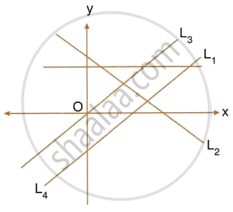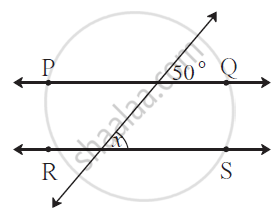Advertisements
Advertisements
प्रश्न
Show that points P(2, –2), Q(7, 3), R(11, –1) and S (6, –6) are vertices of a parallelogram.
उत्तर
The given points are P(2, –2), Q(7, 3), R(11, –1) and S(6, –6).
`"Distance between" = sqrt((x_2 - x_1)^2 + (y_2 - y_1)^2)`
By distance formula,
PQ = `sqrt((7 - 2)^2 + [3 - ( - 2)]^2)`
∴ PQ = `sqrt((7 - 2)^2 + (3 + 2)^2)`
∴ PQ = `sqrt((5)^2 + (5)^2)`
∴ PQ = `sqrt(25 + 25)`
∴ PQ = `sqrt(50)`
∴ PQ = `sqrt(25 × 2)`
∴ PQ = `5sqrt(2)` ...(1)
QR = `sqrt((11 - 7)^2 + (-1 - 3)^2)`
∴ QR = `sqrt((4)^2 + (-4)^2)`
∴ QR = `sqrt(16 + 16)`
∴ QR = `sqrt(32)`
∴ QR = `sqrt(16 × 2)`
∴ QR = `4sqrt(2)` ...(2)
RS = `sqrt((6 - 11)^2 + [-6 - (- 1)]^2)`
∴ RS = `sqrt((- 5)^2 + (-6 + 1)^2)`
∴ RS = `sqrt((- 5)^2 + (-5)^2)`
∴ RS = `sqrt(25 + 25)`
∴ RS = `sqrt(50)`
∴ RS = `sqrt(25 × 2)`
∴ RS = `5sqrt(2)` ...(3)
PS = `sqrt((6 - 2)^2 + [-6 - (- 2)]^2)`
∴ PS = `sqrt((6 - 2)^2 + [-6 + 2]^2)`
∴ PS = `sqrt((4)^2 + (-4)^2)`
∴ PS = `sqrt(16 + 16)`
∴ PS = `sqrt(32)`
∴ PS = `sqrt(16 × 2)`
∴ PS = `4sqrt(2)` ...(4)
In □ PQRS,
PQ = RS ...[From (1) and (3)]
QR = PS ...[From (2) and (4)]
A quadrilateral is a parallelogram, if both the pairs of its opposite sides are congruent.
Checking for slopes,
Slope of a line between two points (x1, y1) and (x2, y2) is
m = `(y_2 - y_1)/(x_2 - x_1)`
Slope PQ = `(7 - 2)/[3 - (- 2)] = 1`
Slope QR = `(11 - 7)/[- 1 - 3] = - 1`
Slope RS = `(6 - 11)/[- 6 - (- 1)] = 1`
Slope SP = `(6 - 2)/[- 6 - (- 2)] = - 1`
As PQ = RS and their slope = 1 And QR = SP and their slope = -1.
∴ □ PQRS is parallelogram.
∴ P, Q, R, and S are vertices of a parallelogram.
APPEARS IN
संबंधित प्रश्न
Write the equation of the line passing through the pair of points (2, 3) and (4, 7) in the form of y = mx + c.
If (4,-3) is a point on the line AB and slope of the line is (-2), write the equation of the line AB.
Find the slope and y-intercept of the line:
ax – by = 0
The equation of a line is x – y = 4. Find its slope and y-intercept. Also, find its inclination.
Is the line 3x + 4y + 7 = 0 perpendicular to the line 28x – 21y + 50 = 0?
Is the line x – 3y = 4 perpendicular to the line 3x – y = 7?
Find the equation of the line passing through (−2, 1) and perpendicular to 4x + 5y = 6.
B(−5, 6) and D(1, 4) are the vertices of rhombus ABCD. Find the equations of diagonals BD and AC.
The line 4x − 3y + 12 = 0 meets x-axis at A. Write the co-ordinates of A. Determine the equation of the line through A and perpendicular to 4x – 3y + 12 = 0.
The point P is the foot of perpendicular from A(−5, 7) to the line whose equation is 2x – 3y + 18 = 0. Determine :
- the equation of the line AP.
- the co-ordinates of P.
Match the equations A, B, C and D with the lines L1, L2, L3 and L4, whose graphs are roughly drawn in the given diagram.
A ≡ y = 2x;
B ≡ y – 2x + 2 = 0;
C ≡ 3x + 2y = 6;
D ≡ y = 2

Find the point on the X–axis which is equidistant from A(–3, 4) and B(1, –4).
Verify that points P(–2, 2), Q(2, 2) and R(2, 7) are vertices of a right angled triangle.
In the figure, line PQ || line RS. Using the information given
in the figure find the value of x.

A straight line passes through the points P(–1, 4) and Q(5, –2). It intersects x-axis at point A and y-axis at point B. M is the mid-point of the line segment AB. Find:
- the equation of the line.
- the co-ordinates of point A and B.
- the co-ordinates of point M.
Three vertices of a parallelogram ABCD taken in order are A(3, 6), B(5, 10) and C(3, 2), find:
- the co-ordinates of the fourth vertex D.
- length of diagonal BD.
- equation of side AB of the parallelogram ABCD.
If (4,-3) is a point on line 5x +8y = c, find the value of c.
A line segment joining P(2, –3) and Q(0, –1) is cut by the x-axis at the point R. A line AB cuts the y-axis at T(0, 6) and is perpendicular to PQ at S.
Find the:
- equation of line PQ
- equation of line AB
- coordinates of points R and S.
